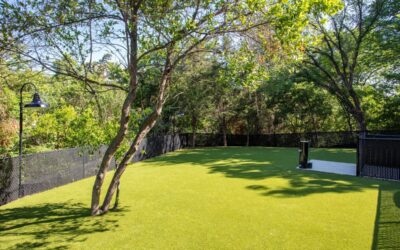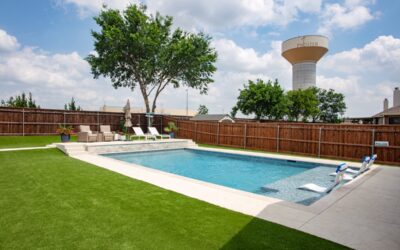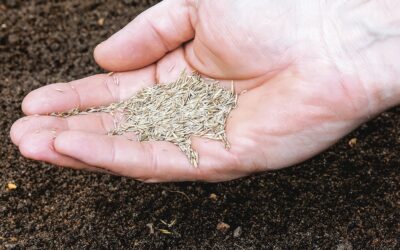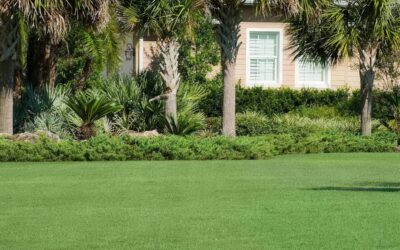Homes and businesses are switching to artificial grass because it looks immaculate all year round—even after heavy rains.
In fact, when professionally installed, the best synthetic grass products stand up excellently to all of the elements, including hot sun and heavy rainfall—as well as dog pee.
Artificial grass allows fluids to pass through its highly porous backing and into the ground below, preventing puddles or pooling on the surface—but there can be problems with inferior grass or poor installations.
Drainage is important! So, let’s take a closer look at artificial grass drainage so that you know what to expect if you’re planning on making the switch from real grass…
How does artificial grass drain water?

Artificial grass is engineered in two main section that are fused together:
- The artificial grass blades that you see and walk on, made from plastic yarn offering varying levels of aesthetics, performance and comfort. The best types of artificial grass closely mimic real grass and are often made from polyethylene monofilament.
- The backing to the grass: this is the main support structure of the grass and consists of two parts: the primary backing, which is a netting-type textile to which the artificial fibers are sewn or stuck (usually made from woven polypropylene) and a secondary layer usually made from either latex or polyurethane.
How does synthetic turf drain?
Grass backing is perforated and semi- or fully permeable, allowing the free drainage of water from the surface to the ground below the grass. Effectively, no barrier exists to water draining away from the grass area just as with real grass—and sometimes even more effectively.
During the installation process, artificial grass professionals spend time to prepare the ground and check the soil/drainage situation. But not all teams perform artificial grass installations to the same standards—and some homeowners do it themselves.
A sub-base layer consisting of 3-4 inches of shale or finely ground rock, decomposed granite, and gravel should be added to the topsoil. This must be compacted just enough to create an even but porous surface for the grass to be laid on—or it could lead to unwanted drainage issues.
Provided the grass is of sufficient quality, professionally installed grass should drain rainwater effectively through the grass and base layer.
Hole-punched turf backing vs fully permeable backing
The most common type of turf backing is hole-punched for drainage. This has been used for many decades with artificial grass. It is proven technology and is suitable for most applications, with drainage holes running through the backing of the turf at equal distances.
Fully permeable backing takes the drainage capabilities up a notch and is preferable for pet lawns, dog runs or areas that require a lot of drainage.
At DFW Turf Solutions, our artificial turf comes with 100 percent permeable backing that optimizes drainage and makes all turf installations suitable for dogs and other pets, as well as the climate.

Potential drainage issues
The sub-base can create drainage issues unless properly prepared. Trying to take “shortcuts” with an installation can interrupt the flow of water, leading to numerous problems (see below).
If problems are flagged with water draining away because of the soil, sub-base layer or another reason during the installation, a drainage system can be created before the artificial grass is laid. Small drainage gaps (usually holes filled with shingle) may be left every 15 cm or so around the perimeter of the area during the ground preparation.
Lying artificial grass directly onto hard bases such as concrete or paving is not usually recommended but drainage holes could be drilled into the area if it is exposed to water/rain.
Another potential drainage issue with new synthetic turf is the infill. This is usually a silica-based material used to add extra weight to the turf to improve stability and create a more realistic appearance and feel. The wrong infill can plug the holes in the backing of the turf and impact drainage.
Attention to detail and ground preparation from professional turf installers is the key to artificial grass that effectively drains water and looks as good as this:

Pro-tip
Did you know that your turf should be laid on a slope of 2-3 percent to allow water to flow away “downhill”?
You may not hear that in too many discussions about drainage but any professional installation company should know that even if an artificial grass lawn looks completely level, it should actually be on a very slight, almost-indiscernible slope! That is, if it’s installed by professionals with an understanding of drainage.

Does artificial grass drain water better than real grass?
Each backyard is different. Before artificial grass is laid to replace real grass, the drainage efficiency of the area should be assessed.
Installation professionals understand the local climate and will create a drainage system in your yard that can handle it. Many homeowners install grass themselves but don’t pay enough attention to potential drainage issues.
Because of the extra attention to detail when installing synthetic turf areas, many artificial grass lawns end up draining better than real grass lawns.

Common problems resulting from drainage issues
Poor drainage is one of the biggest issues with any lawn area—artificial or real grass—and can lead to problems with appearance, health and safety, longevity, cost of ownership, and usability of the lawn area.
Let’s take a closer look at each problem…
Unsightly appearance
No homeowner needs telling that this is a problem:

If water is not draining away from the surface of the artificial grass and, instead, forming puddles, it looks unsightly and will start to damage the appearance of the artificial grass fibers in the longer term.
Poor drainage may also increase the presence of unsightly weeds—a problem that shouldn’t be much of an issue for well-installed, well-kept artificial grass.
Health and safety risks
Constantly wet lawn areas are a slip hazard for people using them. If water doesn’t drain away but rests on the surface, the entire area will be more slippery.
Pooled water can also lead to mold, mildew, odors, bacteria traps, and other nasties. For instance, water attracts mosquitos that can lay eggs, creating another unwanted problem.

More downtime
Properly prepared ground with high-quality grass should ensure a verdant artificial grass area that remains usable all year round because there’s no mud or waterlogging to contend with. Children and dogs can play soon after rainfall.
If water’s pooling on the surface after heavy rains, more “downtime” will result.

Shorter lifespan
Professionally installed artificial grass can last 15-20 years or more. If it suffers drainage problems, its lifespan will be shortened because of the gradual degradation of the fibers.
With a little extra attention during installation, you’ll ensure the artificial grass installation lasts just as long as it should do.
Higher cost of ownership
The cost of artificial grass is relatively high when you install it (compared with real grass) but it pays itself back every year in low maintenance requirements. Usually, it pays itself back in full after five or six years (compared to real grass) and so you’re “in profit” every year afterwards.

If your artificial grass is damaged by poor drainage, you not only increase the potential repair bills but also shorten the turf’s life, so the low-maintenance benefits work for fewer years. This essentially increases the cost of ownership of your synthetic grass.
What causes bad drainage with synthetic turf?
The main cause of bad drainage with artificial grass is poorly prepared ground, as covered already.
When preparing ground, installations professionals should be on the lookout for the following types of issues that can make drainage a challenge:
- Uneven ground surfaces: these need to be flattened so the grass is installed atop a perfectly even surface.
- Clay-based soils: these soils are less permeable and may restrict the flow of water beneath the artificial grass.
- Incorrectly prepared sub-base layer: maybe the wrong sub-base layer is delivered or it’s been compacted too much.
- A high water table: this can prevent water from draining away from the backyard area as it should.
- A backyard that sits lower than the surrounding land: this will naturally cause rainwater to run towards it and settle.
- Incorrect infill: this will plug the drainage holes in the turf’s backing and reduce the permeability of the artificial grass area.

Can you correct bad drainage with artificial grass?
If your artificial grass has been installed incorrectly and it’s draining poorly, don’t try to fix it up yourself. Get back onto your artificial grass company or whoever installed it.
During a professional installation, the team should ensure that that the area is draining adequately well before laying the grass by testing the sub-base layer, watering it well with a garden hose. Then, it should be tested again once the artificial turf is in place.
If drainage is poor, a drainage system must be created until water drains adequately away. Fortunately, most causes of poor drainage in the yard can be addressed by surface flattening and replacing the existing soil with a more suitable sub-base.
However, it’s difficult to fix up bad drainage after the grass is laid. You’ll need to rip up the original installation and start again. This can get expensive, so it’s far better to catch any problems early on and fix them up before the grass is laid and affixed to the sub-base layer.
Then your installation may look as good as this:

If the problem stems from a deep layer of clay-based soil, you may need to create a drainage ditch. The experienced artificial grass installers at DFW Turf Solutions are also landscapers and can look after any drainage issues you may face with your turf installation.
FAQs
Does all artificial grass allow water to pass through?
All good quality artificial grass should allow water to drain if correctly installed. But cheaper grass, poor installation procedures, the wrong base layer, clay-based soils, a concrete base or other issues can create severe drainage challenges.
Can dogs pee on artificial grass?
Yes. If the right artificial pet turf system has been installed by professionals, your dog can pee on the grass and it will drain away. We use an antimicrobial infill to ensure that there are no lasting odors.
Do I need to invest in a separate drainage system for artificial grass?
Most times, no. Drainage considerations are an integral part of the installation process when the team at DFW Turf Solutions manages the project. All the grass we install has an excellent drainage rate of 28-100+ inches per hour per square yard. For every installation, we assess the drainage requirements of the area before laying the turf.

Ready to switch to artificial grass?
Artificial grass drainage must be considered well before you lay any turf.
Buying turf from the DIY store and rolling it out on unprepared ground will land you with an unsightly mess in your yard. Seek professional assistance during the installation so that drainage issues will be resolved along with any other potential difficulties.
Then you can look forward to an artificial grass area that lasts for decades, looks immaculate all year round and saves you money—all with no effort.
Talk to an artificial grass professional at DFW Turf Solutions to discuss your installation options.






